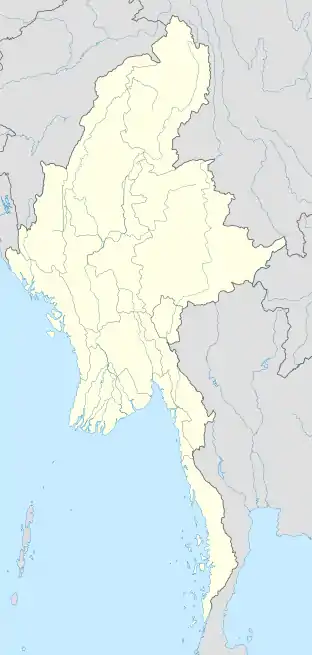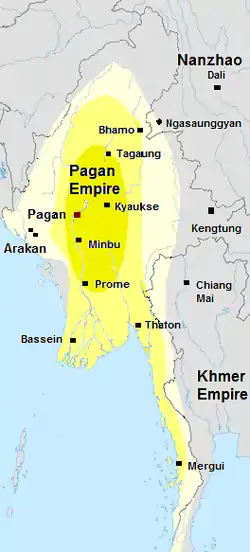باگان
پاگان یا باگان یک شهر باستانی و میراث جهانی یونسکو است که در ناحیه ماندالی میانمار واقع شدهاست.
باگان ပုဂံ Pagan | |
|---|---|
 Temples in Bagan | |
 باگان Location of Bagan, Myanmar | |
| مختصات: ۲۱°۱۰′ شمالی ۹۴°۵۲′ شرقی | |
| Country | میانمار |
| ایالتها و ناحیههای میانمار | ناحیه ماندالی |
| Founded | mid-to-late 9th century |
| مساحت | |
| • کل | ۱۰۴ کیلومتر مربع (۴۰ مایل مربع) |
| جمعیت | |
| • Ethnicities | Bamar |
| • Religions | ترواده |
| منطقه زمانی | یوتیسی +۶٫۳۰ (MST) |
| میراث جهانی یونسکو | |
| نام رسمی | باگان |
| موقعیت | ناحیه ماندالی، میانمار |
| نوع | فرهنگی: iii, iv, vi |
| منابع | ۱۵۸۸ |
| ثبت | ۲۰۱۹ (چهل و سومین نشست) |
| مساحت | ۵٬۰۰۵٫۴۹ هکتار (۱۲٬۳۶۸٫۸ جریب فرنگی) |
| منطقه حائل | ۱۸٬۱۴۶٫۸۳ هکتار (۴۴٬۸۴۱٫۸ جریب فرنگی) |
از قرن نهم تا سیزدهم میلادی، این شهر پایتخت پادشاهی پاگان بود، اولین پادشاهی که مناطقی را که بعداً میانمار مدرن را تشکیل میدهند شامل میشد.
در طول اوج پادشاهی بین سدههای یازدهم و سیزدهم میلادی، ۴٬۴۴۶ معابد بودایی، بتکدهها و صومعهها در دشتهای باگان به تنهایی ساخته شدهاند که از این میان بقایای ۳۸۲۲ معبد و بتکدهها تا امروز پابرجا ماندهاست.
منطقه باستانشناسی باگان یک جاذبه اصلی برای صنعت توریسم نوپای کشور برمه است.[1]
تاریخ
قرن نهم تا سیزدهم

امپراتوری پاگان. ۱۲۱۰
با توجه به تاریخ برمه، باگان در قرن دوم پس از میلاد، و در ۸۴۹ میلادی توسط پادشاه پیینبیا، ۳۴ ام جانشین بنیانگذار اولیه باگان تأسیس شد.[2][3]
منابع
- "Business: The promise—and the pitfalls". The Economist. 25 May 2013. Retrieved 2018-11-26.
- Harvey 1925: 18
- Lieberman 2003: 90–91
- Aung-Thwin, Michael (1985). Pagan: The Origins of Modern Burma. Honolulu: University of Hawai'i Press. ISBN 0-8248-0960-2. Aung-Thwin, Michael (1985). Pagan: The Origins of Modern Burma. Honolulu: University of Hawai'i Press. ISBN 0-8248-0960-2. Aung-Thwin, Michael (1985). Pagan: The Origins of Modern Burma. Honolulu: University of Hawai'i Press. ISBN 0-8248-0960-2.
- Aung-Thwin, Michael (2005). The mists of Rāmañña: The Legend that was Lower Burma (illustrated ed.). Honolulu: University of Hawai'i Press. ISBN 978-0-8248-2886-8. Aung-Thwin, Michael (2005). The mists of Rāmañña: The Legend that was Lower Burma (illustrated ed.). Honolulu: University of Hawai'i Press. ISBN 978-0-8248-2886-8. Aung-Thwin, Michael (2005). The mists of Rāmañña: The Legend that was Lower Burma (illustrated ed.). Honolulu: University of Hawai'i Press. ISBN 978-0-8248-2886-8.
- Ministry of Culture, Union of Myanmar (2009). "Royal Palaces in Myanmar". Ministry of Culture. Archived from the original on 2012-08-03. Retrieved 2012-02-19.
- Harvey, G. E. (1925). History of Burma: From the Earliest Times to 10 March 1824. London: Frank Cass & Co. Ltd.
- Htin Aung, Maung (1967). A History of Burma. New York and London: Cambridge University Press.
- Ishizawa, Yoshiaki; Yasushi Kono (1989). Study on Pagan: research report. Institute of Asian Cultures, Sophia University. p. 239.
- Kala, U (1724). Maha Yazawin (به Burmese). 1–3 (2006, 4th printing ed.). Yangon: Ya-Pyei Publishing.
- Köllner, Helmut; Axel Bruns (1998). Myanmar (Burma) (illustrated ed.). Hunter Publishing. pp. 255. ISBN 978-3-88618-415-6. Köllner, Helmut; Axel Bruns (1998). Myanmar (Burma) (illustrated ed.). Hunter Publishing. pp. 255. ISBN 978-3-88618-415-6. Köllner, Helmut; Axel Bruns (1998). Myanmar (Burma) (illustrated ed.). Hunter Publishing. pp. 255. ISBN 978-3-88618-415-6.
- Lieberman, Victor B. (2003). Strange Parallels: Southeast Asia in Global Context, c. 800–1830, volume 1, Integration on the Mainland. Cambridge University Press. ISBN 978-0-521-80496-7. Lieberman, Victor B. (2003). Strange Parallels: Southeast Asia in Global Context, c. 800–1830, volume 1, Integration on the Mainland. Cambridge University Press. ISBN 978-0-521-80496-7. Lieberman, Victor B. (2003). Strange Parallels: Southeast Asia in Global Context, c. 800–1830, volume 1, Integration on the Mainland. Cambridge University Press. ISBN 978-0-521-80496-7.
- Pan Eiswe Star; Soe Than Linn (2010-02-10). "Archaeologists to assist with Cambodia excavations". 26 (509).
- Royal Historical Commission of Burma (1832). Hmannan Yazawin (به Burmese). 1–3 (2003 ed.). Yangon: Ministry of Information, Myanmar.
- Rao, V.K. (2013). "The Terracotta Plaques of Pagan: Indian Influence and Burmese Innovations". Ancient Asia. 4: 7. doi:10.5334/aa.12310.
- رائو، وینای کومار. "بودایی هنر پاگان، ۲ جلد" منتشر شده توسط انتشارات آگام کلا، دهلی نو، ۲۰۱۱. شابک ۹۷۸-۸۱-۷۳۲۰-۱۱۶-۵ شماره استاندارد بینالمللی کتاب 978-81-7320-116-5.
- Rao, Vinay Kumar (2013). "The Terracotta Plaques of Pagan: Indian Influence and Burmese Innovations". Ancient Asia. 4: 7. doi:10.5334/aa.12310.
- Stadtner, Donald M. (2011). Sacred Sites of Burma: Myth and Folklore in an Evolving Spiritual Realm. Bangkok: 2011. ISBN 978-974-9863-60-2. Stadtner, Donald M. (2011). Sacred Sites of Burma: Myth and Folklore in an Evolving Spiritual Realm. Bangkok: 2011. ISBN 978-974-9863-60-2. Stadtner, Donald M. (2011). Sacred Sites of Burma: Myth and Folklore in an Evolving Spiritual Realm. Bangkok: 2011. ISBN 978-974-9863-60-2.
- Than Tun (December 1959). "History of Burma: A.D. 1300–1400". XLII.
- Than Tun (1964). Studies in Burmese History (به Burmese). 1. Yangon: Maha Dagon.
- Tourtellot, Jonathan B. (2004-09-03). "Dictators "Defacing" Famed Burma Temples". National Geographic.
- UNESCO (1976). Unesco Courier. 28. Paris: یونسکو.
- UNESCO. "Bagan Archaeological Area and Monuments". UNESCO. Retrieved 2012-02-18.
پیوند به بیرون
- نقشه باگان نقشههای آنلاین DPS.
- راهنمای سفر باگان
- همه چیز درباره Bagan (نسخه انگلیسی)
- تصاویر سفر رایگان باگان
- زندگی بودا در ۸۰ صحنه ، معبد آناندا چارلز دوروئزل، بررسی باستانشناسی هند، گزارش سالانه، دهلی، ۱۹۱۳–۱۴
- فرهنگ و هنر برمه - دوره پاگان دکتر ریچارد م. کولر، دانشگاه ایلینویای شمالی
- معماری تاریخی آسیا: باقان پروفسور رابرت دی. فیالا، دانشگاه کنکوردیا، نبراسکا
- معماری بودایی در باگان باب هادسون، دانشگاه سیدنی، استرالیا
- عکسهای معابد و نقاشیهای باقان قسمت ۱ و قسمت ۲
- کارت پستالهای متحرک Bagan
This article is issued from Wikipedia. The text is licensed under Creative Commons - Attribution - Sharealike. Additional terms may apply for the media files.